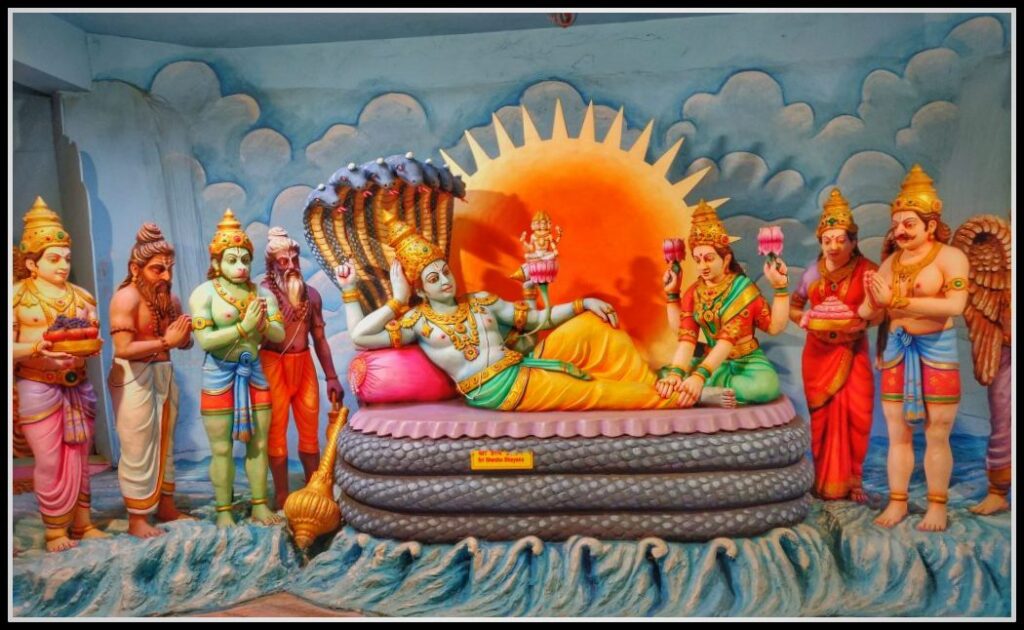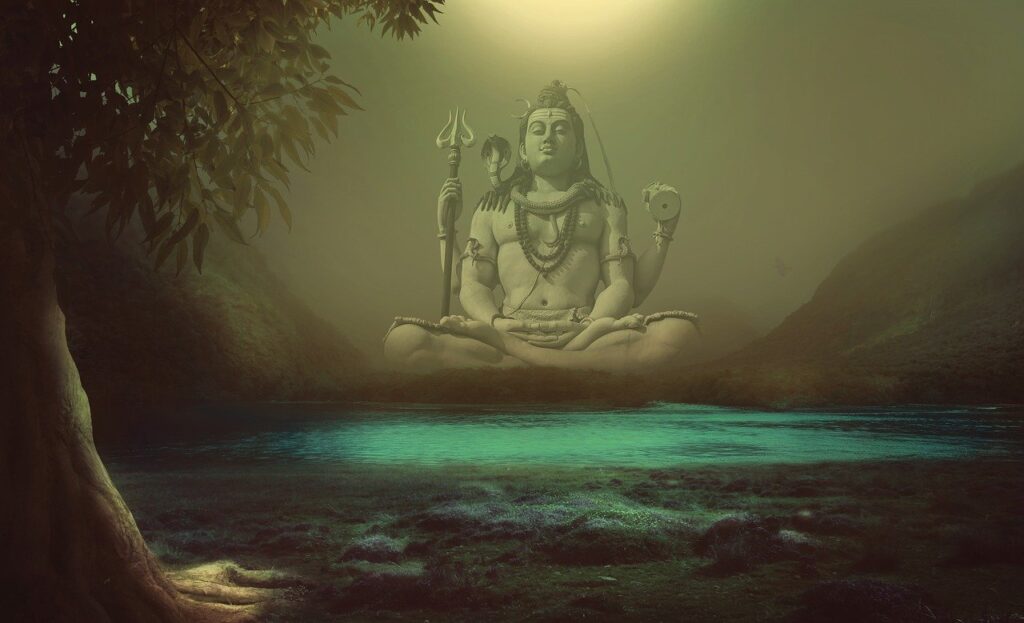
Lord Vishnu is one of the three divine beings in the Trimurti and is recognized for his role as the sustainer of the universe, as well as being one of the primary deities in Hinduism. He is worshiped by many and is known to reside in Vaikuntha loka, which is a spiritual realm. In Vaikuntha loka, he is referred to as Narayana. Krishnaloka is considered the supreme planet of the spiritual world and is believed to be the transcendental abode of Krishna. It is divided into three sections, Dwarka, Mathura, and Goloka. In this abode, the Supreme Lord manifests himself into four plenary expansions – Krishna, Balarama, Pradyumna, and Aniruddha. In this article we shall discuss as to why Vishnu is also referred to as Bhagwan or God.
Balarama, who resides in Krishnaloka, is considered the original Sankarshana and is the source of Maha-Sankarshana, who resides in the Vaikuntha planets. Maha-Sankarshana is responsible for maintaining the planets in the spiritual sky. Maha-Vishnu, who lies on the causal ocean and is the source of all universes, is an expansion of the Sankarshana. Garbhodakasayi Vishnu is an expansion of Maha Vishnu and enters each universe to create Brahma, the first living creature of the universe. Garbhodakasayi Vishnu further expands into Ksirodakasayi Vishnu, who exists in the heart of every living entity as the Supersoul. Therefore, Lord Balarama is considered the original Sankarshana, and Maha-Sankarshana and the Purusha avatars are his plenary expansions.
Diparcir eva hi dasantaram abhyupetya
Dipayate vivrta hetu samana dharma
Yas tadrg eva hi ca vishnutaya vibhati
Govindam adi purusam tam aham bhajami
(Brahma Samhita 5.46)
–
When one candle lights other candles, they all burn with the same intensity and same quality. Still, the first candle may be said to be the original one. In the same way, although so many Vishnus may expand from Him, Krishna is the original Supreme Personality of Godhead. I adore that primeval Lord Govinda.
In the physical world, Vishnu appears in three main forms: Maha Vishnu, who is the soul of the entire creation; Garbhodakshayi Vishnu, who is the soul of each universe; and Ksirodakasayi Vishnu, the antaryami, who is the soul within every living being and atom. Vishnu’s consort is Lakshmi, and his carrier is Garuda, the giant eagle. He is often depicted as being blue in color and has four arms, each of which carries a symbol – conch, lotus, disc, and club. The club and disc are meant for Vishnu’s enemies, who violate the codes of religion and the laws of nature. The disc, which has a thousand spokes, symbolizes the wheel of unyielding time, known as kala-chakra. On the other hand, the lotus and conch shell are meant to bring joy and happiness to Vishnu’s devotees. Here is how Srimad Bhagavatam glorifies Lord Vishnu who is also referred to as Sri Hari.

Harir hi nirgunah saksat prakrteh parah
Sa sarva-drg upadrasta tam bhajan nirguno bhavet
(Srimad Bhagavatam 10..88.5)
–
Sri Hari (Vishnu) is beyond the modes of material nature. He is the Supreme transcendental Person. He is the all-seeing eternal witness. and is the Supreme overseer of all living entities. Whoever takes shelter at His lotus feet and worships Him attains transcendence to material nature.
Maha Vishnu
Maha Vishnu is the Purusha avatar who originates from Narayana, the Lord of Vaikuntha. Maha Vishnu is the source of the vast expanse of spiritual water known as the Causal ocean (Karana sagar). This is why the causal ocean is also known as ‘Sankarsanatmaka’ as it is created from the body of Sankarsana Maha-Vishnu. Maha Vishnu lies on the causal ocean resting upon the bed of Ananta Sesha. As He rests on the causal ocean or ‘Karana sagar’, Maha Vishnu is sometimes also referred to as ‘Karanarnava-sayi Vishnu’. He glances at material nature (Prakriti), thus impregnating her with the seeds of the material universes and the spiritual sparks who populate those universes. Lord Maha-Vishnu then expands Himself into innumerable Garbodakasayi Vishnus in all of these universes.
Garbhodakasayi Vishnu
Garbhodakasayi Vishnu lies within the water of each universe and from His navel sprouts a lotus stem on whose atop sits Brahma, the chief engineer of the universe. The stem of this lotus is the resting place of the multitude of planets. When Garbhodakasayi Vishnu first enters a universe, he finds it dark and empty, with no place to reside. He first creates the universal water from the perspiration of His body, which fills half of the universe. He makes His own residence in these waters and thereafter manifests the planetary systems, in the other half of the universe. Within these universal waters, He manifests Vaikuntha, His own abode, and rests on it upon the bed of Ananta Sesha.
Ksirodakasayi Vishnu
Ksirodakasayi Vishnu, the Lord of the ocean of milk, manifests within the heart of every living being in a suitable size. In the case of human beings, His size is that of one pradesa (distance between the tips of a person’s extended thumb and index finger). Ksirodakasayi Visnu is commonly referred to as the Supersoul. Within the ocean of milk, there exists the island of Svetadvipa which is the abode of Ksirodakasayi Vishnu. Unable to find Him, the demigods, go to the shore of the milk ocean and offer prayers unto Him. Ksirodakasayi Vishnu descends to preserve the material world and vanquish principles of irreligion, millennium after millennium. Ksirodakasayi Vishnu is counted both among Purusha and Guna avatars of the Supreme Lord.
Vishnu and Shiva
Lord Vishnu exists beyond the material world and is considered transcendental. However, he assumes the form of Lord Shiva who associates with material nature or Maya shakti. Shiva is responsible for destroying the material universe and presides over those who are influenced by the mode of ignorance.

Ksiram yatha dadhi vikara visesa yogat
Sanjayate na hi tatah prthag asti hetoh
Yah sambhutam api tatha samupaiti karyat
Govindam adi purusham tam aham bhajami
(Brahma Samhita 5.45)
–
Milk changes into yogurt when it is mixed with a yogurt culture; but yogurt is neither the same nor different from milk, its source. I adore the primeval Lord Govinda of whom the state of Shiva is similarly a transformation for the performance of the work of destruction.Yac-chauca-nihsrta sarit pravarodakena
Turthena murdhny adhikrtenasivah sivo bhut
Dhyatur manah samala saila nisrsta vajram
Dhyayec ciram bhagavastas caranaravindam
(Srimad Bhagavatam 3.28.22)
–
The blessed Lord Shiva becomes all the more blessed by bearing upon his head the holy waters of the Ganges, which has its source in the water that washed the Lord’s (Vamana deva) lotus feet. The Lord’s lotus feet act like thunderbolts launched to shatter the mountain of sin accumulated in the mind of the meditating devotee. One should therefore meditate on the lotus feet of the Lord for a prolonged period of time.
Srimad Bhagavatam reveals that Lord Shiva is the foremost of all the Vaishnavas (devotees of Vishnu).
vaishnavanam yatha sambhuh
purananam idam tatha
(SB – 12.13.16)
Dasavatara – Ten incarnations of Vishnu
The Bhagavat Purana provides a list of twenty-two incarnations of Vishnu, but the ten primary incarnations, known as the Dashavatar, are as follows:
- Matsya – The fish incarnation of the Supreme Lord who towed the boat carrying seeds of every form of life and secured it to a peak in the Himalayan range. In this way, the Lord ensured the continuity of life in this world, saving it from the waters of universal annihilation. Like Varaha deva, the Mastya avatar also appears twice in a day of Brahma. In His first incarnation, he kills the demon Hayagriva (who steals the Vedas from Brahma) and rescues the Vedas. In His second avatar, He protects life on this world from the universal waters.
- Kurma – The tortoise incarnation of the Supreme Lord, whose shell served as a pivot for the Mandara hill, that was used as a churning rod by the demigods (devas) and the demons (asuras) during samudra manthan (churning of the milk ocean). Kurma avatar also perpetually holds up the earth and maintains it in its position in the universe.
- Varaha – Boar incarnation of the Supreme Lord who lifted earth from the nether regions of the universe, after killing the demon Hiranyaksha with His tusks. Hiranyaksha was responsible for drowning the earth in the great ocean of the universe. Varaha avatar appears twice in a day of Brahma. He first appears during the reign of Svayambhuva Manu where He lifts the earth from the lower regions of the universe. He appears again during Chaksusa Manu and this time while lifting the earth, He also kills the demon Hiranyaksha.
- Narasimha – Lord Narasimhadeva appeared from a pillar to protect His devotee Prahlada and vanquish the demon Hiranyakashipu, Prahlada’s father, who was trying to kill his own son. Lord Narasimha deva appeared in the sixth Manvantara, which happened before the churning of the milk ocean. This avatar has many vilasa expansions like Lakshmi Narasimha, Ugra Narasimha and others, each possessing different bodily complexions and activities.
- Vamana – The dwarf Brahmana incarnation of the Lord who tricked Bali maharaj by asking for three steps of land, and thereby denying him of all his material possessions. The King ultimately dedicated his own body to fulfill the measurement of the Lord’s third step. Vamana deva was won over by Bali Maharaj and hence the Lord served as the King’s doorkeeper.
- Bhargava Parasurama – The Supreme Lord appeared as the brahmana named Parasurama, who was the son of Renuka and Jamadagni. He was a descendant of Bhrigu muni. He vanquished all the Kings, encircling the world twenty one times. He was angry with them as they had deviated from religious principles.
- Ramachandra – Lord Rama appeared in Treta Yuga. He was the son of Dasaratha and Kausalya. He killed the demon Ravana.
- Balarama – Balarama is the brother of Lord Krishna. He is the first expansion of the Supreme Lord. Lord Balarama first entered the womb of Devaki and was then conveyed to the womb of Rohini. Thus He literally has two mothers. Balarama expands as Sankarsana who also manifests Himself as the holder of the earth and also the bed of Lord Vishnu.
- Buddha – Son of Anjana, Buddha deludes the atheists, by speaking on sub-religious principles.
- Kalki – Kalki avatar appears at the conjunction of Kali and Satya yugas. By this time, the rulers of earth degenerate into plunderers. Kalki avatar makes His appearance to annihilate the miscreants and re-establish the postulates of eternal religion. He appears as the son of Vishnuyasha, an eminent brahmana of a village named Shambhala.